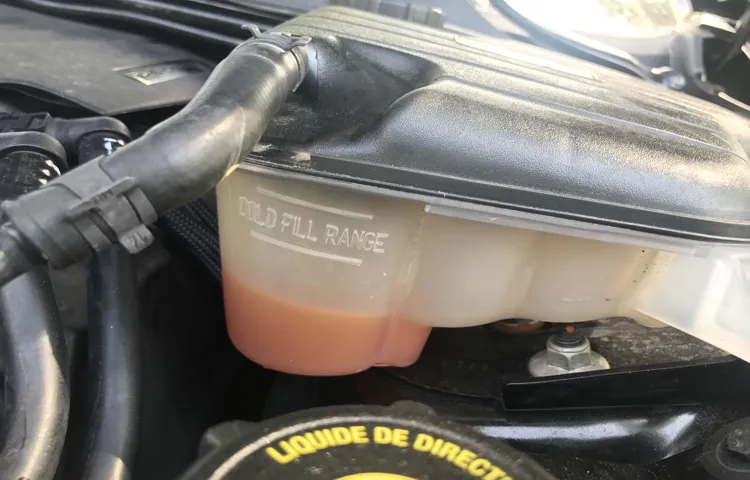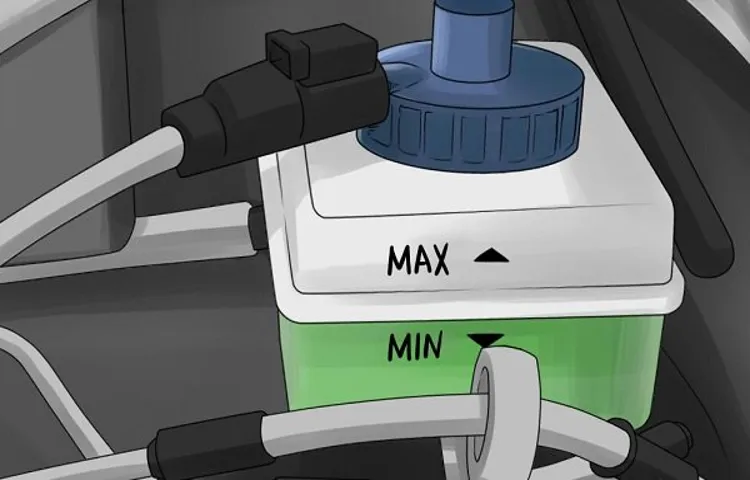Have you ever wondered what that little tank under your car’s hood is for? You know, the one with the cap that says “coolant”? Well, if you’re like many car owners, you may not have given it much thought. But understanding coolant level is actually quite important for the health and performance of your vehicle. Think of coolant as your car’s internal air conditioning system.
Just as you rely on air conditioning to keep you cool on a hot summer day, your car relies on coolant to keep its engine cool and prevent overheating. Without enough coolant, your engine can overheat, causing serious damage and potentially leaving you stranded on the side of the road. So how do you know if your coolant level is where it should be? One simple way is to check the level of coolant in the tank under your hood.
This tank should have a “minimum” and “maximum” line on the side, indicating the ideal range for coolant level. If the level is below the minimum line, it’s time to top it up. If you’ve never checked your coolant level before, don’t worry! It’s an easy task that you can do yourself.
All you need is a jug of coolant (which you can buy at any auto parts store) and a funnel. Simply remove the cap from the coolant tank, place the funnel in the opening, and pour the coolant in slowly until it reaches the maximum line. Be sure to wipe up any spills and securely replace the cap when you’re finished.
By regularly checking and maintaining your coolant level, you can help ensure that your engine stays cool and your car keeps running smoothly. So take a few minutes to pop the hood and give your coolant tank a quick glance. Your car will thank you!
Table of Contents
What is Coolant?
Coolant is a liquid that is used to regulate the temperature of an engine. It plays a crucial role in maintaining the optimum operating temperature of the engine and preventing it from overheating. Coolant circulates through the engine and absorbs heat generated during combustion.
It then flows through the radiator, where it is cooled down before returning to the engine. The level of coolant in the engine should be regularly checked to ensure that it is at the correct level. If the coolant level is low, it can lead to overheating and potentially cause damage to the engine.
So, it is important to keep an eye on the coolant level and top it up if necessary. Regular maintenance of the coolant system is essential for the smooth functioning of the engine and to prevent any cooling-related issues.
Definition and Purpose of Coolant
coolant, purpose of coolant

Types of Coolants
coolants, different types of coolants, coolant definition, types of engine coolants, types of radiator coolants, coolant for car engines
Significance of Maintaining Coolant Level
coolant level, maintaining coolant level, significance, coolant In order to understand the significance of maintaining the coolant level in your vehicle, it’s important to first understand what coolant is. Coolant, also known as antifreeze, is a liquid that is used to regulate the temperature of your engine. It circulates through the engine, absorbing heat and then dissipating it through the radiator.
This helps to prevent your engine from overheating, which can cause serious damage and lead to costly repairs. Keeping the coolant level at the correct level is crucial for ensuring that your engine stays cool and operates efficiently. If the coolant level is too low, there may not be enough coolant to effectively cool the engine, which can lead to overheating.
On the other hand, if the coolant level is too high, it can cause excess pressure in the cooling system, which can lead to leaks or other damage. Maintaining the proper coolant level is not only important for keeping your engine cool, but it also helps to prevent rust and corrosion within the cooling system. Coolant contains additives that help to lubricate and protect the various components of the cooling system, such as the radiator and water pump.
Without enough coolant, these components can become damaged, leading to expensive repairs. In addition to protecting your engine and cooling system, maintaining the coolant level can also help to improve fuel efficiency. When your engine is running at the proper temperature, it operates more efficiently, which can lead to better gas mileage.
This means that you can save money at the pump by simply keeping an eye on your coolant level. In conclusion, maintaining the coolant level in your vehicle is crucial for keeping your engine cool and preventing damage. By regularly checking and topping off the coolant, you can ensure that your engine operates efficiently, improves fuel efficiency, and avoids costly repairs.
So, make sure to keep an eye on that coolant level and keep your engine running smoothly!
How to Check Coolant Level
“What is coolant level?” is a common question that many car owners may ask. Coolant is a liquid that helps to regulate the temperature inside the engine of a vehicle. It absorbs heat and prevents the engine from overheating during operation.
The coolant level refers to the amount of coolant that is present in the engine’s cooling system. Checking the coolant level is an important part of regular car maintenance. It ensures that there is enough coolant to keep the engine cool and prevents any potential damage from overheating.
To check the coolant level, you can find the coolant reservoir in the engine bay. The reservoir usually has a minimum and maximum level marked on it. Simply remove the cap and check the level against these marks.
If the coolant level falls below the minimum mark, it’s time to add more coolant. It’s important to note that the engine should be cool before checking the coolant level to prevent any injuries. Regularly monitoring and maintaining the coolant level can help to keep your car running smoothly and prevent any costly repairs in the future.
Step-by-Step Guide to Checking Coolant Level
Checking the coolant level in your vehicle is an essential part of routine maintenance. Coolant, also known as antifreeze, is responsible for regulating the temperature of your engine and preventing it from overheating. If the coolant level is too low, it can lead to engine damage and costly repairs.
To check the coolant level, start by locating the coolant reservoir. It is usually a translucent plastic tank with markings indicating the minimum and maximum levels. Make sure the engine is cool before attempting to check the coolant level.
Once the engine is cool, remove the cap from the coolant reservoir and visually inspect the level. It should be between the minimum and maximum markings. If the level is low, you can add coolant to bring it up to the appropriate level.
It’s important to use the correct type of coolant for your vehicle, so refer to the owner’s manual or consult a professional if you’re unsure. Additionally, if you consistently find that your coolant level is low, it may indicate a leak in the cooling system that should be addressed as soon as possible. Regularly checking and maintaining your coolant level is a simple yet crucial step in keeping your engine cool and avoiding costly repairs.
Tools Required for Checking Coolant Level
coolant level, checking coolant level, tools for checking coolant level
Common Mistakes to Avoid When Checking Coolant Level
coolant level, checking coolant level, common mistakes, avoid, coolant level, checking coolant level, check coolant, properly, overheating, damage, vehicle, engine, radiator, reservoir, cold engine, warm, expansion tank, coolant level indicator, add coolant, small increments, , top off, fill to the level, dealership, professional. Are you familiar with the process of checking your vehicle’s coolant level? If not, it’s important to learn how to do so properly to avoid potential damage to your engine. One common mistake that people make when checking their coolant level is doing it with a warm engine.
It’s crucial to wait for your engine to cool down completely before attempting to check the coolant level. This is because when the engine is warm, the coolant expands and can give you a false reading. Another mistake to avoid is relying solely on the radiator to check the coolant level.
Many vehicles have a separate reservoir where the coolant is stored, and this is the best place to check the level. Look for the coolant level indicator on the reservoir and add coolant in small increments if needed. It’s important not to overfill the reservoir, so top it off gradually and fill it to the indicated level.
If you’re unsure about how to check your coolant level or add coolant, it’s always a good idea to consult your vehicle’s owner’s manual or visit a dealership or professional for assistance.
Why is Maintaining Coolant Level Important?
Coolant is a vital component in keeping your vehicle’s engine cool and preventing it from overheating. The coolant level refers to the amount of coolant fluid present in the radiator and cooling system. Maintaining the proper coolant level is important for several reasons.
Firstly, the coolant helps to regulate the temperature of the engine by absorbing and dissipating heat. If the coolant level is too low, there may not be enough fluid to effectively cool the engine, leading to overheating. Secondly, the coolant also contains additives that prevent corrosion and rust from forming inside the engine, which can lead to costly repairs.
Additionally, the coolant helps to maintain the efficiency of the engine by lubricating various components, such as the water pump. Regularly checking and maintaining the coolant level is essential for keeping your engine running smoothly and preventing potential damage.
Preventing Engine Overheating
maintaining coolant level
Ensuring Proper Functioning of Cooling System
coolant level, HVAC system, overheating, car engine, maintenance The proper functioning of the cooling system in any machine, whether it’s an HVAC system or a car engine, is crucial for its overall performance and longevity. One key aspect of maintaining this system is ensuring the coolant level is always at the right level. But why is this so important? Well, think of it as the lifeblood of the cooling system.
Just like our bodies need a proper amount of blood to function optimally, machines need the right amount of coolant to prevent overheating. If the coolant level is too low, the system will struggle to cool down the engine or the space it is meant to cool. This can result in damage to crucial components and even lead to costly repairs.
On the other hand, if there is too much coolant in the system, it can cause a buildup of pressure, leading to leaks and potential damage. Regularly checking and maintaining the coolant level is a simple yet effective way to ensure the cooling system keeps everything running smoothly. So, the next time you’re checking your car’s fluids or inspecting your HVAC system, don’t forget to pay attention to the coolant level.
Your machine will thank you for it.
Preventing Engine Damage
coolant level, preventing engine damage
When to Add Coolant?
Coolant level refers to the amount of coolant fluid that is present in the radiator of a vehicle. It is essential to regularly check and maintain the coolant level to ensure that the engine does not overheat. Coolant, also known as antifreeze, is responsible for regulating the temperature of the engine by absorbing the excess heat generated during operation.
When the coolant level is low, it can lead to overheating, which can cause severe damage to the engine. Therefore, it is crucial to add coolant when the level is low. To check the coolant level, you can refer to the owner’s manual for specific instructions on how to do so in your particular vehicle.
It is recommended to add coolant mixture, which is a combination of antifreeze and water, to maintain the proper level as indicated on the coolant reservoir. Regularly checking the coolant level and adding coolant when necessary is an essential part of vehicle maintenance to ensure the optimal performance and longevity of the engine.
Signs of Low Coolant Level
Low coolant levels can cause a lot of problems for your vehicle, so it’s important to know when to add coolant. One of the first signs that your coolant level is low is if your vehicle starts to overheat. This could mean that there isn’t enough coolant to keep the engine cool, which can lead to serious damage if not addressed.
Another sign to look out for is if your heater isn’t blowing hot air. This could be a sign that there isn’t enough coolant circulating through the system to keep the heater core warm. Additionally, if you notice a sweet smell coming from your engine or see a pool of coolant under your vehicle, it’s a clear indication that you need to add coolant.
Overall, it’s important to regularly check your coolant level and add coolant as needed to ensure that your vehicle runs smoothly and doesn’t overheat.
Safety Precautions for Adding Coolant
Adding coolant to your vehicle is an essential part of routine maintenance. Coolant helps regulate the temperature of your engine, preventing it from overheating and causing damage. But how do you know when it’s time to add coolant? One of the easiest ways to check is by looking at the coolant reservoir, which is a clear plastic container located near the radiator.
If the coolant level is below the minimum mark, it’s time to add more. It’s also a good idea to check the coolant level before long trips or during hot summer months when your engine is more likely to overheat. Keeping an eye on the coolant level can help prevent costly repairs and keep your engine running smoothly.
Conclusion
So what is coolant level? Well, imagine your car’s cooling system as a hot cup of coffee. Coolant is like the creamer that gets poured in to keep the coffee temperature just right. But just like you wouldn’t want to drown your coffee in creamer, having an excessive coolant level can cause problems too.
On the other hand, having too little coolant is like sipping on a scorching black coffee – it’s not good for you or your engine. So, keeping an eye on your coolant level is crucial for maintaining a well-balanced and smooth-running vehicle. Remember, when it comes to coolant, moderation is key!
FAQs about Coolant Levels
What is coolant level and why is it important for your vehicle? Coolant, also known as antifreeze, is a crucial component of your vehicle’s cooling system. It helps regulate the temperature of your engine and prevents it from overheating. The coolant level refers to the amount of coolant that is present in your vehicle’s radiator and overflow reservoir.
Maintaining the proper coolant level is essential for the optimal performance and longevity of your engine. Without enough coolant, your engine can overheat and suffer from costly damage. On the other hand, having too much coolant can also cause problems, such as pressure buildup and leaks.
To ensure your vehicle stays in good condition, it’s important to regularly check and maintain the coolant level.
FAQs
What is coolant level?
Coolant level refers to the amount of coolant or antifreeze present in a vehicle’s cooling system. It is crucial to maintain the proper coolant level to prevent engine overheating and ensure optimal performance.
How can I check the coolant level in my car?
To check the coolant level in your car, park it on a level surface and allow the engine to cool down. Open the hood and locate the coolant reservoir. The reservoir will have minimum and maximum marks indicating the desired level. Use a flashlight to see the level, and if it is below the minimum mark, add coolant until it reaches the recommended level.
Why is checking the coolant level important?
Checking the coolant level is important because coolant is essential for regulating the engine’s temperature. If the coolant level is low, it may result in engine overheating, which can cause severe damage and potential breakdowns. Regularly checking and maintaining the coolant level can help prevent costly repairs and ensure smooth operation of your vehicle.
What happens if the coolant level is too low?
If the coolant level is too low, it can lead to engine overheating. When the engine overheats, it may cause damage to various components, such as the cylinder head gasket, engine block, or pistons. Over time, the lack of coolant can result in severe engine damage and potentially render the vehicle inoperable.
Can I use water instead of coolant if the level is low?
In an emergency situation, you can use water to top up the coolant level temporarily. However, using water as a substitute for coolant is not recommended for prolonged periods or in cold weather. Coolant contains additives that help prevent corrosion, lubricate components, and provide freeze protection. It is best to add the appropriate coolant mixture to maintain the ideal coolant level.
How often should I check the coolant level?
It is recommended to check the coolant level at least once a month or before long trips. Additionally, you should check the coolant level whenever you notice any signs of engine overheating, such as the temperature gauge reaching the red zone or steam coming from under the hood.
What are the common causes of low coolant level?
Low coolant level can be caused by various factors, including coolant leaks, evaporation, or coolant consumption due to engine overheating or other issues. Coolant leaks can be caused by a faulty radiator, leaking hoses, a damaged water pump, or a cracked engine block or cylinder head. If you notice a consistent drop in coolant level, it is essential to identify and address the underlying cause promptly.



